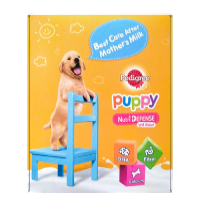
In this section
Kibble size: why it matters for small breed dogs

share:
Dry kibble is a popular meal option for many pet parents, owing to the ease and convenience associated with it. Unlike perishable food, it does not require refrigeration and hence is easy to store. This also makes it the perfect dog food to travel with for quick on-the-go meals. It does not spoil easily when left in a bowl for a while and hence is ideal for free feeders. However, dry kibble also has other important advantages. While it is nutritionally balanced and complete with all the necessary vitamins and minerals, it also provides a crunch—something that is integral for a dog’s oral health.
Dogs have always enjoyed a good chew or crunch in their food, ever since their primal pack days. The texture of dry kibble ensures that dogs chew before they swallow, which helps reduce plaque and tartar buildup along with improving digestion. This is also why kibble eaters tend to have better breath than those that eat home-cooked food.
Another advantage of dry dog food is kibble size—normal-sized kibble for bigger dogs and small kibble for toy, small and medium dogs. Regular kibble is an excellent choice for bigger dogs as it encourages proper chewing time in larger mouths. They have wider jaws and stronger teeth which makes it easier for them to chew on relatively bigger pieces of food. Unless they are fast eaters, there is no real danger of choking. If bigger dogs are fed small kibble, it might result in them swallowing without actually chewing the kibble. However, small kibble is very beneficial for their smaller cousins.
Review this article:








